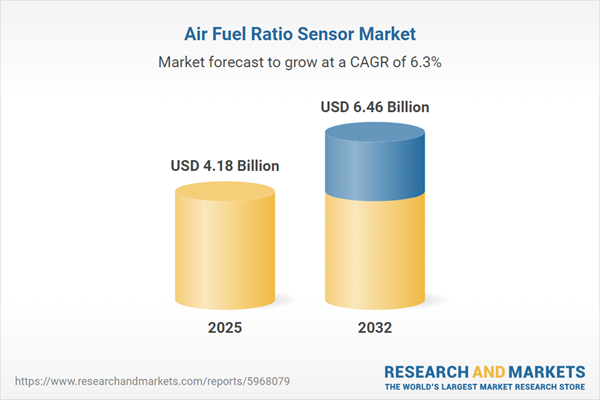Speak directly to the analyst to clarify any post sales queries you may have.
The air fuel ratio sensor market is an essential segment supporting the modern evolution of powertrain technology and emissions compliance in automotive and industrial contexts. As innovation, environmental regulations, and supply chain dynamics continue to shape sector priorities, understanding this landscape is vital for strategic leaders.
Market Snapshot: Air Fuel Ratio Sensor Market Growth and Outlook
The Air Fuel Ratio Sensor Market grew from USD 3.95 billion in 2024 to USD 4.18 billion in 2025. It is expected to continue growing at a CAGR of 6.32%, reaching USD 6.46 billion by 2032. This robust growth is driven by stricter emissions standards worldwide, increased integration across hybrid and traditional powertrains, and rapid advancements in materials and sensor technology. Stakeholders are addressing new challenges, particularly in global trade and digital transformation, while pursuing opportunities presented by enhanced sensing precision and modular design in rapidly evolving vehicle architectures.
Scope & Segmentation of the Air Fuel Ratio Sensor Market
- Sensor Types: Titania oxygen sensors, wideband oxygen sensors, zirconia oxygen sensors.
- Vehicle Powertrains: Hybrid electric vehicles, plug-in hybrid electric vehicles, diesel engines, gasoline engines (internal combustion).
- Voltage Range: High, medium, low voltage applications.
- Integration Approaches: Integrated systems, standalone systems.
- Technology Formats: Analog sensors, digital sensors, solid-state sensors.
- Sales Channels: Aftermarket (offline and online), original equipment manufacturer (OEM).
- Applications: Emission control (heavy/light vehicles), performance monitoring (adventure, racing vehicles).
- End-Use Industries: Automotive (commercial, passenger vehicles), aerospace (civil, military aviation), industrial (construction, manufacturing equipment), marine (commercial vessels, personal watercraft).
- Regions Covered: Americas (United States, Canada, Mexico, Brazil, Argentina, Chile, Colombia, Peru), Europe, Middle East & Africa (United Kingdom, Germany, France, Russia, Italy, Spain, Netherlands, Sweden, Poland, Switzerland, UAE, Saudi Arabia, Qatar, Turkey, Israel, South Africa, Nigeria, Egypt, Kenya), Asia-Pacific (China, India, Japan, Australia, South Korea, Indonesia, Thailand, Malaysia, Singapore, Taiwan).
- Major Companies Profiled: Leading innovators and suppliers such as AEM Electronics, Autoliv Inc., Continental AG, Delphi by Phinia Inc., Denso Corporation, Faurecia SE, General Motors Holdings LLC, HELLA GmbH & Co. KGaA, Honeywell International Inc., Infineon Technologies AG, Panasonic Corporation, Robert Bosch GmbH, Siemens AG, Texas Instruments Incorporated, and others.
Key Takeaways for Senior Decision-Makers
- Regulatory pressures are driving OEMs and industrial users to invest in high-precision, durable air fuel ratio sensors that ensure compliance and optimized combustion efficiency.
- Material innovation, including solid-state substrates and nanostructured coatings, is extending sensor lifespan and improving reliability under adverse operating conditions.
- Integration of advanced processing and real-time calibration is facilitating the shift toward consolidated powertrain systems, enabling adaptive control and predictive diagnostics.
- Supplier diversification and the rise of digital procurement channels are offsetting costs and logistical disruptions stemming from evolving trade and tariff environments.
- Regional dynamics reveal that Asia-Pacific is rapidly expanding its role through electrification policies and manufacturing scale, while Europe and North America set regulatory benchmarks and maintain high standards of manufacturing sophistication.
- Companies enhancing their portfolios with post-sales support, such as remote calibration or analytics-driven services, are deepening customer retention and value delivery.
Tariff Impact and Strategic Supply Chain Adaptations
Recent US tariffs on imported sensing components and materials are prompting significant changes across global supply chains. Manufacturers now increasingly consider nearshoring and diversification of supplier networks to maintain cost control and secure essential inputs. This shift drives strategic collaborations in allied regions and may accelerate investments in local production capabilities. As organizations adjust, enhanced digital channels and value-added aftermarket services are helping maintain market competitiveness against higher landed costs.
Methodology & Data Sources
This research leverages a mixed-method approach, combining detailed literature and patent reviews, proprietary dataset analysis, and structured interviews with stakeholders across OEMs, regulators, and service providers. Data triangulation and expert validation ensure the reliability and actionability of market forecasts and segmentation analysis.
Why This Report Matters
- Enables clear benchmarking of emerging air fuel ratio sensor technologies and strategic evaluation of evolving regional opportunities.
- Equips leaders with actionable insights for risk mitigation and market expansion, including supply chain adaptation under new tariff regulations.
- Delivers a transparent overview of best-in-class players, enabling selective partnership and competitive intelligence decisions.
Conclusion
The air fuel ratio sensor market is undergoing significant transformation, shaped by global regulatory, technological, and policy changes. For decision-makers, leveraging these insights is crucial to align strategies with both current and anticipated market demands.
Additional Product Information:
- Purchase of this report includes 1 year online access with quarterly updates.
- This report can be updated on request. Please contact our Customer Experience team using the Ask a Question widget on our website.
Table of Contents
3. Executive Summary
4. Market Overview
7. Cumulative Impact of Artificial Intelligence 2025
Companies Mentioned
The companies profiled in this Air Fuel Ratio Sensor market report include:- AEM Electronics
- Autoliv Inc.
- Ceradex Corporation
- Continental AG
- Delphi by Phinia Inc.
- Denso Corporation
- Faurecia SE
- Francisco Albero S.A.U.
- General Motors Holdings LLC
- HELLA GmbH & Co. KGaA
- Hitachi Ltd.
- Honeywell International Inc.
- Infineon Technologies AG
- K&N Engineering, Inc.,
- MTE Thomson
- NGK Spark Plug Co., Ltd.
- Niterra Co., Ltd.
- NXP Semiconductors N.V.
- Panasonic Corporation
- Robert Bosch GmbH
- Sensata Technologies, Inc.
- Siemens AG
- STMicroelectronics N.V.
- Texas Instruments Incorporated
- Valeo SA
Table Information
| Report Attribute | Details |
|---|---|
| No. of Pages | 194 |
| Published | November 2025 |
| Forecast Period | 2025 - 2032 |
| Estimated Market Value ( USD | $ 4.18 Billion |
| Forecasted Market Value ( USD | $ 6.46 Billion |
| Compound Annual Growth Rate | 6.3% |
| Regions Covered | Global |
| No. of Companies Mentioned | 26 |









